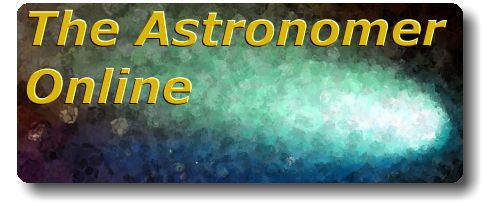
Last Updated:
2017 Jan 15 15:49 UTC
Source file:
1996comets.txt


Last Updated: |

|
Contents
|
22P/KopffThis ninth magnitude comet was in a similar area of sky to Hale-Bopp during the summer of 1996. This image was obtained by Martin Mobberley at 0146 on 1996 May 21. He used a 160s exposure with an SX camera on his 0.49m, f/4.5 Newtonian. South is at the top in this 9.7x6.0 arcmin view. By 1996 July 17 the comet was around -20 degrees declination and Martin obtained another image using the 0.49m.C/1996 B2 (Hyakutake)This comet, the second to be discovered in a month by Hyakutake, exceeded expectations and was an incredible object. It was at its best at close appoach in late March but it also put on a spectacular show as it moved in towards the sun in April. It was recovered by southern hemisphere observers in mid-may as it moved away from the sun.When it was discovered the comet was far south of the equator. David Strange obtained this image on 1996 February 15. It is a 4x40 sec exposure using a Starlite Xpress + 50cm f/4 Newtonian at 0520h U.T. A bright central condensation is visible. A false colour image reveals a coma offset slightly towards the west It was taken in fairly hazy skies, and at Dec -24deg the seeing conditions were far from perfect. The image has south to the top and is 7x5 arcmin in size. The comet had brightened considerably by the time that Martin Mobberley took this image on 1996 February 27. He used a 0.49-m Newtonian and an SX camera. By 1996 March 17 the comet had grown a substantial tail as shown in this image from David Strange. The image was taken 0101UT with a 4x80s exposure using an SX camera and a 135mm, f/2.8 lens. David comments: "Through the 50cm f/4, ten second exposures show a short pointed tail two arc minutes long coming from the central condensation in PA 275 deg. Visually in the 50cm the coma fills a 30 arcmin field of view, and the comet is now an easy naked eye object. Between March 22 and March 26 TA observers Nick James, Martin Mobberley and Glyn Marsh travelled to Tenerife to observe the Great Comet of 1996. The weather in the Canaries was certainly an improvement on that in the UK and the detail visible in the tail was incredible. The comet was observed over four nights around closest approach and some of the best images obtained are included here.
The rotation of the comet's nucleus is well shown in this 34k MPEG movie of the central coma region. Terry Platt Obtained nine frames of the comet at roughly half hour intervals between 1940 and 2341 on 1996 April 1. A jet is seen eminating from the spinning nucleus rather like water from a garden sprinkler. A spectacular photograph the comet was obtained by Gerald Rhemann from Ebenwaldhöhe, Austria. He used a 190/255/435mm Schmidt and Kodak Gold Pro 400 film in 120 format. This is a 4 minute exposure taken at 1946UT on 1996 April 17. It clearly shows both the gas and the dust tails of the comet. A prominent tail is visible in this image taken at the prime focus of a 5.1", f/6 Astrophysics refractor by Andy Sefton. The photo is a 5 minute exposure on hypered Ektachrome 320T at 2150UT on 1996 April 18. C/1996 B1 (Szczepanski)This comet was discovered on 1996 January 27 by Edward Szczepanski of Houston. The comet has a perihelion about 0.45 a.u. outside the earth's orbit.On 1996 January 31 Denis Buczynski obtained this relatively wide field frame showing the comet. He used a 500mm, f/3.5 Celestron Comet Catcher, a 180s exposure and an SX camera. The field of view is roughly 45 x 30 arcmin. On the next morning Nick James took this picture of the comet using a 0.30m Newtonian, a ten minute exposure and an SX camera. The field of view in this case is about 13 x 9 arcmin with north at the top. At the time the comet was in Ursa Major. C/1995 Y1 (Hyakutake)"H. Sato, National Astronomical Observatory, Tokyo; and S. Nakano, Sumoto, Japan, report the visual discovery by Yuji Hyakutake of a comet. The discoverer, based at Hayato, Aira-gun, Kagoshima-ken used 25x150B for the discovery and described the comet as diffuse and of diameter 3.5 arc-minutes."On 1996 February 1 Martin Mobberley took this picture of the comet using an 80s exposure with an SX camera and his 0.49m Newtonian. South is at the top in this 10 x 6 arcmin frame. C/1996 Q1 (Tabur)Comet Tabur was discovered by Vello Tabur on 1996 August 19. At that time the comet was a tenth magnitude fuzz in Eridanus. The orbit is highly inclined as shown in this orbit diagram.The comet was quite condensed as can be seen in this image taken on 1996 September 16 by Giuseppe Sala from St. Barthelemy in Northern Italy. This is a 120s exposure at 0348 using a 25cm LX200 at f6.3 and an SXL8 camera. The field of view is 14" x 13" but the orientation is unknown. A nice short tail is visible in this image of 1996 September 21 taken by Denis Buczynski. He used the Celestron Comet Catcher and an SX camera at 0355. By 1996 October 16 the comet had a prominent tailward pointing jet. This image was taken by Nick James using a 0.30m Newtonian and an SX camera. The image was processed using an unsharp mask and a log stretch. |
|
Webmaster: Peter Meadows |